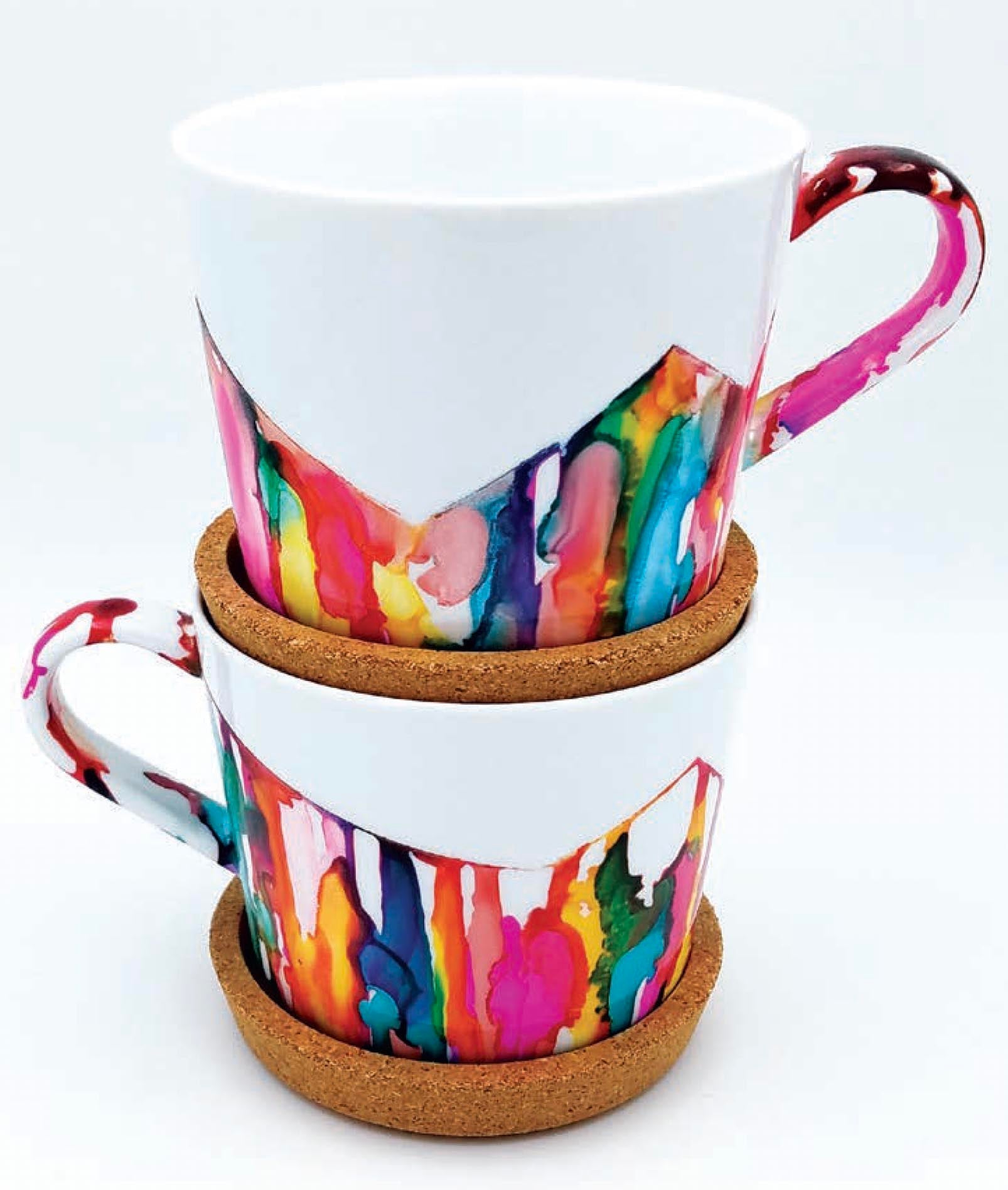
With inside access to all things Piñata, it's hard to resist trying to use them on just about everything. From YUPO and clayboard, to canvas, denim and glass, it's been fun exploring different substrates that these vibrant alcohol inks bloom on.
When two plain jane coffee mugs and five new Piñata colors showed up in my studio, it only seemed fitting to create something uniquely colorful!

SUPPLIES YOU'LL NEED:
- 2 white ceramic mugs
- Jacquard Piñata Alcohol Inks in these colours:
- 004 Golden Yellow
- 006 Pink
- 008 Coral
- 016 Blue-Violet
- 020 Teal
- 036 Pearl
- Jacquard Piñata Claro Extender
- Jacquard Piñata Clean Up Solution
- 70% Isopropyl Alcohol
- Paper Towels
- Cotton Swabs
- Gloves
- 3M Masking Tape
- Krylon Kamar Spray Varnish
- Krylon UV-Resistant Clear Gloss Varnish
- Krylon Triple-Thick Clear Glaze
Step by Step: How to Colour Your Mug
1.
Hand wash mugs with hot soapy water, rinse well and dry thoroughly. While you wait, prep your work area by protecting the surface and laying out everything you'll need.
Using 3-6" strips of 3M masking tape, mask off the area you want to keep plain. I used a loose, zigzag edge, but you could simply go around parallel, or make waves, stripes... feel free to be creative, just ensure the mug rim is masked off 1-2" from the top (these inks and varnishes are not food safe). If your pieces are decorative only, masking the rim is optional (but the white area creates great contrast with the vibrant colours).

2.
Turn mugs upside down, then select a lighter colour from your palette. Keeping the bottle tip close to the surface at a slight angle, gently squeeze the bottle to dispense your ink, moving around the mug edge to create paths of colour.
Be sure to drip a little ink on the handles as well. Try to avoid adding ink to the base of the mug (but don't stress, it can always be cleaned off later!)


3.
While the first color is still wet, repeat this process with a second color. Alcohol inks tend to be very cohesive; if you drip your second color close to your first, it will seek out the same drip path and blend. Try for a varied mix of cohesive blends and distinctly separate color drips as you move around and add more colors. I worked light to dark in the five non-metallic colors I chose (Coral, Golden Yellow, Pink, Teal, Blue-Violet) using the Blue-Violet very sparingly to avoid losing distinction between the colours.
While I tend to use Claro Extender and spritzes of 70% Isopropyl Alcohol in other projects to achieve pebble effects and unique halos of colour, I used both very sparingly in this project, as I intended to keep a very drippy effect, but feel free to explore these to achieve different blends and effects.
4.
The last colour I used was Pearl, which is a really interesting colour. It is not only a metallic ink, it also contains highly-reflective mica particles. When it comes in contact with other vivid Piñata Colours, unique pearlescent shimmers and blends happen. I love all of the metallics, but I think Pearl is my favourite!

Remember how I mentioned trying to keep the colour off the mug base? Well, I wanted to demonstrate the shimmer effect of the Pearl mixing with other colours, and the flat surface of the mug base was the best place
to make it happen (I cleaned it off in later steps).
5.
Let the mugs dry overnight, then remove tape and discard. Interestingly, only two of
the colors permeated the adhesive of the 3M tape (Coral and Pink). If you run into ink
bleeding under the tape line, simply put a little Clean Up Solution on a paper towel and scrub off any bleeds from the masked area and mug base. You can also use a cotton swab with Clean Up to crisp up your line work.


6.
Once your mugs have dried for 24 hours, you'll need to seal them. Since these var-
nishes are not food grade, you will want to carefully mask off the unpainted rim area
of your mugs with 3M masking tape prior to varnishing (you can skip masking the
unpainted areas if your pieces are decorative only).
Varnishing alcohol inks on ceramic is a 3-part process, and the product type and order of use really does matter. Alcohol Inks can be easily reactivated by varnishes, so be sure to carefully follow these instructions to avoid a sad blurry mess!
- In a well-ventilated area (outdoors out of direct sunlight is recommended), spray your overturned mugs with 2-3 light coats of the Kamar Varnish, allowing 60 minutes dry time between coats. Cure 24 hours.
- Spray 2-3 light coats of UV-Resistant Clear Varnish, again allowing 60 minutes dry time between coats. Cure 24 hours.
- Finish with 2 light coats of Triple Thick Clear Glaze, allowing 60 minutes dry time between coats. Final cure 24-48 hours.
HELPFUL NOTES:
- Stay 8-10" away from pieces when spraying, and spray in light, sweeping strokes across the piece (not straight on, otherwise you may end up with varnish drips).
- In between spray coats and curing time, protect your mugs from having dust settling on them by covering them with a plastic bucket or other container large enough to cover them without touching.
- Handle these little beauties with care once they're done... hand wash only with non-abrasive sponge and mild dish soap. Do not put in the microwave (especially important when metallic inks are used, otherwise those metal pigments may result in a surprise light show!)
ABOUT THE ARTIST:
Tanya Alexander is a Graphic / Web Designer at Jacquard Products. She is also a lifelong fine artist working in a variety of mediums, including: traditional acrylic canvas work, pen and ink, ceramics, textile art, face/body painting, large format muraling and artistic neo-traditional tattooing.
Tanya has enjoyed experimenting with a wide variety of new mediums while working at Jacquard, including Silk Colors, Piñata Alcohol Inks, Textile Color, Lumiere, Neopaque, Pearl Ex Powdered Pigments, Cyanotype, Indigo and more.
You can find Tanya's work on Instagram, Etsy and the web: artbytanyaalexander
Thank you to our friends at Jacquard Products and artist Tanya Alexander for sharing this article with us.

